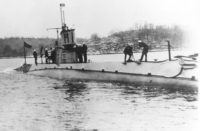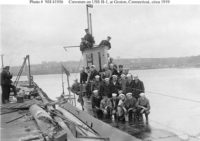Underwater archaeologists from Mexico’s National Institute of Anthropology and History (INAH) have recorded and created a 3D model of the wreck of the USS H-1 Seawolf submarine, a torpedo boat used by the US Navy during World War I to patrol the northeast Atlantic coast. It wasn’t sunk on the Atlantic coast, however, nor in US waters, nor even during the war, for that matter.
 Originally named Seawolf — the first US Navy ship to be named after the formidably betoothed fish — the submarine was built by the Union Iron Works in San Francisco in 1911, the diesel engines by Electric Boat in New London, Connecticut. She was renamed the less exciting H-1 in November of that year and launched in 1913. H-1 was the lead ship of the H-class submarines and patrolled the West Coast until a few months after the United States entered World War I in April 1917. That October, she was deployed to New London and patrolled the Atlantic coast around Long Island Sound until the war’s end. She was ordered back to her home base in San Pedro, California, in January 1920.
Originally named Seawolf — the first US Navy ship to be named after the formidably betoothed fish — the submarine was built by the Union Iron Works in San Francisco in 1911, the diesel engines by Electric Boat in New London, Connecticut. She was renamed the less exciting H-1 in November of that year and launched in 1913. H-1 was the lead ship of the H-class submarines and patrolled the West Coast until a few months after the United States entered World War I in April 1917. That October, she was deployed to New London and patrolled the Atlantic coast around Long Island Sound until the war’s end. She was ordered back to her home base in San Pedro, California, in January 1920.
After crossing the Panama Canal, the H-1 went ran aground on a shoal off the coast of Santa Margarita Island in Mexico’s Baja California on March 12th, 1920. The 25 members of crew were able to evacuate but four of them, including its commanding officer Lieutenant Commander James R. Webb, died in the attempt to swim to shore. (See the list of survivors and some photos of the submarine aground before it sank here.)
 The Navy tried to raise the submarine. She was pulled off the rocks briefly, only to sink 50 feet down to the seabed. On April 12th, H-1 was officially stricken from the Naval Vessel Register. The exact location of the wreck was also unknown until 2016 when a local photographer reported the presence of a historic submarine wreck west of Santa Margarita Island. Apparently it had been surreptitiously rediscovered by fishermen a few years earlier and looted for its bronze.
The Navy tried to raise the submarine. She was pulled off the rocks briefly, only to sink 50 feet down to the seabed. On April 12th, H-1 was officially stricken from the Naval Vessel Register. The exact location of the wreck was also unknown until 2016 when a local photographer reported the presence of a historic submarine wreck west of Santa Margarita Island. Apparently it had been surreptitiously rediscovered by fishermen a few years earlier and looted for its bronze.
Since the report, INAH archaeologists have explored the wreck in two diving seasons, one in 2017 and a second in 2018. The first exploration photographed the site and took measurements.
“From stern to bow, the boat measures 44.30 meters; from aft, at 31.8 meters, the structure collapses and the area of controls is observed, and later that of torpedoes; The turret part is also collapsed. The state of the hull is bad and where it has been lost there are multiple holes that reveal the submarine’s skeleton. The stern section is full of sand, ” explained [Roberto Junco, head of INAH’s Underwater Archaeology branch].
The second expedition deployed photogrammetry, the first time the technology has been used in Mexico, to document the entire vessel in painstaking detail. The thousands of high-resolution photographs taken have been stitched together to make a 3D model of the wreck. Researchers will be able to study the wreck using the model and monitor its conservation status.
“With this software we can analyze very small elements. This model has enormous utility, because over time we can continue monitoring the deterioration of the boat, with great accuracy, either by currents or natural degradation of the material with which it was built. This way we will follow up that will allow you to assess your status every two or three years, and we will be able to identify possible areas of ‘ant’ [small parts] looting, ” he added.
At this time, Junco revealed, the H-1 investigation is in the historical part, to reconstruct the role of these artifacts in the First World War. What will follow in the explorations will be to identify which parts are intact, in terms of instruments and decorative elements that provide more information on technological equipment and cultural data.
Amazing 3d visual.
It’s great that INAH has gone to so much effort to diligently survey this wreck. It’s important work and shouldn’t be taken for granted.